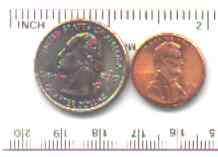STOLTENHOFF COIN SET - SHIP'S HISTORIES
Stoltenhoff Island is a now uninhabited island that is governed by
Tristan da Cuhna.
It is named after
the brothers Gustav and
Friedrich Stoltenhoff who unsuccessfully tried to settle the island
between 1871 and 1873. Tristan da Cuhna recently released the
first coins ever issued for the island. The set
of eight legal-tender coins for Stoltenhoff Island was struck by the
Commonwealth Mint. The obverse of each coin features Queen
Elizabeth. Various
sailing ships and
boats associated
with Tristan da Cuhna and Stoltenhof Island are on the
reverse.
Due to its isolation in the South Atlantic, Ships played a major roll
in the life of Tristan da Cuhna group. Included in the Eight coin set
is a 39mm copper-nickel 1 Crown, bimetallic 25 Pence, brass 20 pence,
copper-nickel 10 and 5 pence and bronze 2, 1, and 1/2 Pence, all dated
2008. The coins are Uncirculated though most coins have some
minor bagmarks.
Item S-STOLT-SET8 STOLTENHOFF IS. 8 COIN
SET 1/2 PENCE - 1 CROWN UNC. out
SHIPS
APPEARING ON STOTENHOFF ISLAND COINS:
Half Penny:
West Riding Tragedy
Longboat
In the afternoon of November 27th 1885 the island's worst ever recorded
disaster happened when the iron barque West Riding called at Tristan
for water. Following the failure of the potato harvest and driven by a
great need for provisions, 19 men took to their new life-boat and set
out into very rough seas to try and intercept the ship. But just as
they approached the West Riding the boat was overcome by a sudden
violent squall and sank, drowning all but 4 of its crew.
One Penny
Portuguese Ship captained
by Tristao
da Cunha (Can find no record of its name...)
This ship, a Portuguese Carrack, captained by Tristao da Cunha was part
of a 13 ship fleet under the command of Alfonso de Alburquerque, first
Viceroy of Portuguese India, on its way from Lisbon to India via the
Cape of Good Hope. However, a violent storm dispersed his fleet and da
Cunha's ship was blown far south where he came across the islands which
still bear his name.
Two Pence
HMS Julia
HM Sloop of War Julia with 95 crew on board becomes the victim of the
island's first major tragedy when as a result of a sudden gale she
founders on what subsequently became known as the Julia Reef on 2
October 1817 with the loss of 50 officers and men.
Five Pence
HMS Beagle
On 26 March 1824, artist Augustus Earle arrived at the island on board
the 'Duke of Gloucester' and "Hoping to be able to add a few
interesting drawings to my portfolio, as this was a spot hitherto
unvisited by any artist..." was granted permission to spend 1 day
ashore painting. Unfortunately, a sudden gale blew up, the Duke of
Gloucester was forced out to sea, and his 1 day turned into 8 months
during which he was stranded with only his painting equipment and the
clothes he stood up in. He was taken in by Governor Glass and his wife
and spent his time on the island as clergyman and teacher. He later
became famous when he joined Charles Darwin aboard HMS Beagle as his
artist and passed by the islands once again on the leg from Cape Town
to St Helena. He painted several canvasses of the island and island
life.
Ten Pence
Blenden Hall
The 450 tonne East Indiaman on its way to Bombay struck the breakers on
the NW side of Inaccessible Island in a dense fog on the 23rd of July
1821. All souls survive, although the master and a sailor were killed
on the reefs trying to get to the coast by swimming. The survivors
spend several months living in improvised tents eating fish, seabirds
and penguins and made a makeshift boat with which the ship's carpenter
and nine men sailed to Tristan and returned the next day accompanied by
the Governor of Tristan, William Glass in his two boats and by November
12th, all remaining survivors had been taken to Tristan.
Twenty Pence
HMS Satellite
This was the brig of war which brought Alexander Cotton of Hull (aka
John Taylor), successor to William Glass as the second Governor of
Tristan to the island to settle on June 21, 1821 along with John Mooney
and deserting sailor Kenneth McIntosh.
Twenty-five Pence
Iron Barque West Riding
This was the ship which on its way from Bristol to Sydney, Australia
called at Tristan for fresh water and became caught up in the worst
disaster in the island's recorded history, when 15 men perished trying
to get to the West Riding in search of desperately needed provisions
for the starving islanders.
One Crown
L'Heure du Berger
This was the first ship to survey the group of 5 islands in the Tristan
archipelago. Soundings were taken and a rough survey of the coastline
was made. Notes were made of evidence of fresh water on the island by
the presence of a large waterfall, Big Watron and a lake on the north
coast. The results of the survey were published by Royal Navy
Hydrographer A. Dalrymple in 1781.

